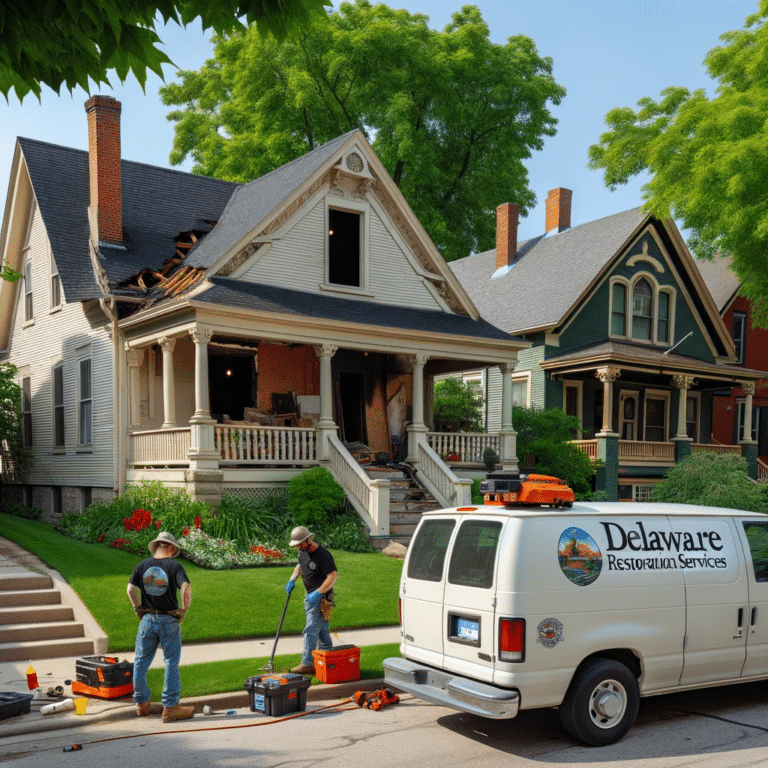Emergency Restoration Services in Delaware, OH | iDry 24/7
Why iDry Columbus is Your Go-To for Emergency Restoration Services in Delaware
🕒 Always Available: Emergencies strike at any hour. That’s why our team is on standby 24/7, ensuring we’re here when you need us most.
🧼 Comprehensive Care: From tackling water damage and mold outbreaks to neutralizing stubborn odors, our expertise covers all aspects of restoration to bring your property back to its best.
📞 Transparent Pricing: We believe in honesty upfront. Receive a straightforward quote without hidden fees, helping you make informed decisions.
Ready for a hassle-free restoration experience? Contact us now for your complimentary, no-obligation estimate!
Contact Us for a Free Property Damage Inspection
24/7 Emergency Restoration Services
Licensed, Insured & Dedicated
Free Estimates: Xactimate™ Technology
Why iDry Columbus Stands Out as Your Emergency Restoration Services in Delaware
- ⌛ Swift Response: We don’t waste time. When you call, we’re on our way, no matter the hour.
- 🛠️ Specialized Expertise: From flood recovery to odor elimination, we handle it all with skill and care.
- 💬 Upfront Communication: We keep you in the loop with transparent pricing and regular updates.
Searching for a skilled restoration service in Delaware? iDry has the expertise and reliability you need to tackle any restoration challenge.
Ready to get started? Contact us for a no-obligation quote.
Why iDry Columbus is the "Go-To" Restoration Company Near Me in Delaware
When you’re faced with property damage, choosing a reliable restoration company in Delaware is crucial. Here’s why iDry Columbus is the top pick for residents and businesses alike.
Local Knowledge: We know Delaware, Ohio, like the back of our hands. Our local insight helps us offer services that are right on the mark.
Ready Anytime: Facing a water leak at 3 a.m.? Don’t worry. We’re available 24/7 to handle emergencies. Check out our water damage restore 247 pages to see how we can limit further damage, day or night.
Expert Crew: Our team isn’t just skilled; they’re experts. We use cutting-edge technology to make sure the job is done right the first time.
You Come First: We keep you in the loop and listen to your concerns. After all, this is your property we’re talking about.
All-in-One Service: From water and mold damage to deep cleaning, we do it all. You won’t need to call anyone else.
So, if you’re seeking a restoration company in Delaware that covers all the bases, look no further than iDry Columbus. Contact us for more info or to get started with a service.
A Closer Look at Our Restoration and Cleaning Services
At iDry Columbus, we offer a variety of services designed to meet your emergency restoration services in Delaware, Ohio. Whether you’re dealing with water damage, fire damage, or simply require deep cleaning, our skilled team is here to assist.
Water Damage Cleanup: Water damage can be devastating and requires immediate attention. Our team uses advanced equipment and proven techniques to extract water, dry out your property, and prevent mold growth.
Fire Damage Restoration: After a fire, your property may be left with soot, smoke damage, and water damage from firefighting efforts. Our fire damage restoration service aims to clean up, repair, and restore your property to pre-fire condition.
Mold Remediation: Mold isn’t just unsightly; it can also pose serious health risks and weaken your property’s structure. We offer comprehensive mold inspections and effective treatments to make sure your property is safe and mold-free. Curious about the cost? Visit our mold removal cost calculator to get a quick idea.
Sewage Backup Cleanup: When sewage problems strike, they’re not just messy—they’re hazardous. Whether it’s a minor backup or an issue like sewage cleanup under your house, our team is trained to handle it safely and efficiently, ensuring your space is sanitized and safe
Discover the superior service of iDry Columbus today and see why we are the favored restoration company in Delaware for all your emergency restoration service needs. Contact our friendly team for more information or to schedule a service.
Valuable Local Resources for Delaware, Ohio Residents
When dealing with property damage, it’s crucial to be aware of the various resources available to you. Below are some local and relevant external authorities where Delaware, Ohio residents can find additional information and support:
Delaware County Emergency Management Agency: In case of a disaster, the Delaware County EMA provides vital resources and information to help residents prepare and respond effectively.
American Red Cross of Delaware County: The local branch of the American Red Cross provides disaster relief and preparedness education for Delaware, Ohio, residents.
These resources, combined with our expert restoration and cleaning services at iDry Columbus, can help you navigate the challenging times following property damage in Delaware, Ohio. We’re committed to providing you with the support you need to restore your property and peace of mind.
Frequently Asked Questions about Our Services
We understand you may have many questions about restoration and cleaning services, especially after a stressful event like a fire or flood.
How much does it usually cost for water damage repair?
Good question. The cost can vary a lot depending on the extent of the damage. We offer free water damage estimates to give you a clearer picture of what you might spend.
I found mold in my basement; what do I do now?
Don’t panic. First, avoid touching or disturbing the mold. Give us a call, and we’ll handle the mold remediation for you, making your home safe again.
Do you guys clean up after fires too?
Absolutely. We take care of soot and smoke damage and even help with structural repairs. Our goal is to get your property back to pre-fire conditions.
My basement flooded; how fast can you get here?
We understand that speed is crucial in a situation like this. That’s why we offer 24/7 emergency services. In most cases, we can be there within an hour to start the cleanup.
Real Stories from Our Satisfied Customers
At iDry Columbus, we take pride in delivering exceptional service. But don’t just take our word for it. Read on to hear directly from our customers about their experiences. These testimonials reflect our commitment to excellence and our dedication to restoring homes and businesses in Delaware, Ohio, and the surrounding areas.
I have never met a more professional and productive company. The most impressive group of people from the first phone call to the completed job. Very respectful and informative
Lisa V.
Curtis showed up to my house at 10pm after I called him in tears. They had started soon after that!! Curtis and his crew are amazing!! Curtis made sure my house was taken care of and done to perfection. Friendly, trustworthy, efficient and amazing!! Curtis checked in often and everyone did a great job!! I highly recommend iDry Columbus and the wonderful crew!!
Nicki C.
I have to say that these are two of the absolutely most professional, kind, courteous, thorough, on-time amazing a contractor type people I have ever been around. They did a wonderful job and was so kind and caring and I would recommend them to anyone. They are top notch all the way around.
Amy C.
Restoration Experts
Covering Ohio. We’re here for you.








